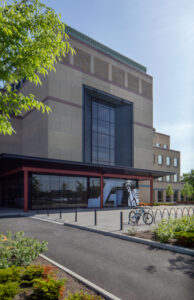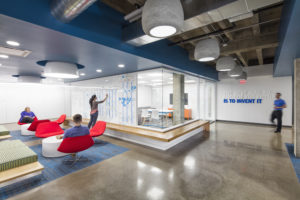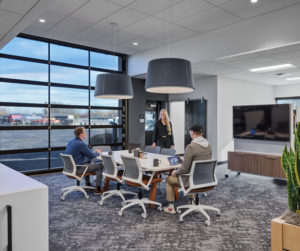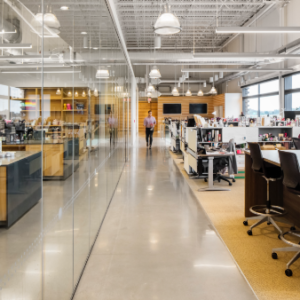Creating Environments for Everybody and Every Body
Today’s employees demand that work feel less like work and more like a place to pursue passions – a place that facilitates diversity, equity, and inclusion.
WSA project architects Matt Kisseberth and Alex Nyktas, along with design specialists Aleah Springer and Tianna Williams sat down for a roundtable Q+A to discuss how these values inform design, and how to create environments that work for everybody and ever body.
What does accessible design mean? What does equitable design mean?
 Springer: The first thought is physical accessibility. But when that is paired with equitability it opens the questions, and you have to think about the overlap.
Springer: The first thought is physical accessibility. But when that is paired with equitability it opens the questions, and you have to think about the overlap.
Williams: Code should be viewed as the bare minimum. I started to question design decisions through the lens of a kid, years ago, watching my grandmother struggle to navigate throughout spaces in her wheelchair. Too often designers get to the code requirements and stop. To truly create equitable and accessible design, You have to keep thinking about how design impacts the environment and the diverse experiences of the end-users.
Nyktas: It’s thoughtful design for everyone. It lifts other up, and creates a place not just to survive, but thrive.
Kisseberth: Scale is involved too. It’s one thing to put in a ramp, but where do we locate buildings and set up accessibility for a broader audience? It’s about thinking how a place fits into a wider environment and becomes a destination in the network around it.
How can the design of space foster inclusivity?
Williams: You have to think about the experience, not just physically, but mentally as well. How does the end-user experience the space as they move throughout? How do they see, touch, and feel in the environment? Consider all their senses and how they might engage? These considerations are the start of making an environment intentionally inclusive.
Springer: Integrating design, so code formalities aren’t one instance. Informing the design beyond those requirements creates spaces meant for everyone.
 Nyktas: When those pieces respond and adapt in a seamless way, and when measures put in places aren’t obvious, that natural feeling makes a space feel inviting.
Nyktas: When those pieces respond and adapt in a seamless way, and when measures put in places aren’t obvious, that natural feeling makes a space feel inviting.
Kisseberth: The design can create a place where people feel welcome, where it’s natural to bring people in. We can create intersections for natural interaction – areas that bring people together. When you combine that with organizations made up of people from different backgrounds, those interactions, when people are naturally coming together, it makes people feel welcome.
Are there standard practices that create barriers to accessibility and equity?
Nyktas: There’s a barrier of cost. Our role as designers is to include these considerations that don’t come at a massive financial cost. Creative solutions can achieve lofty goals without a lofty price.
Kisseberth: A lot of it is about providing choices and opportunities. We can look back at an era where you were either in a cubicle farm or a private office. But now we’re focused on letting people make their own decisions on how to work comfortably and productively. That means thinking more about total space. People like to find spaces that make them comfortable and that helps them be productive. We have to take that same attitude in how we approach everything: buildings, offices, public spaces – every piece should be somewhere someone can find their spot.
 Springer: We’re starting to see more design choices like garage doors that provide visual connections to the outside and flexibility for a space. Harnessing technology and making sure workplaces have access to technology and can be accessed virtually is another need. When spaces don’t have those kinds of things, it starts to feel exclusive.
Springer: We’re starting to see more design choices like garage doors that provide visual connections to the outside and flexibility for a space. Harnessing technology and making sure workplaces have access to technology and can be accessed virtually is another need. When spaces don’t have those kinds of things, it starts to feel exclusive.
Williams: Having a lack of diverse perspectives in design conversations is a common barrier in the industry. There’s a level of reeducation and understanding that needs to happen. To become more inclusive, design professionals need to develop a better understanding of exclusion. Not to mention, what worked 20 to 30 years ago, even 5 years ago might not work now. As design professionals, we have a skillset for curating creative design solutions that help address challenges from all angles—and challenging our industry’s standard barriers, are no different.
What does an environment that works for everybody and every body look like?
 Williams: It’s a space that the moment anyone walks in, they feel a sense of belonging. They feel welcome and inspired. It encompasses how they’re treated, viewed, and experience the space. For example, gender-neutral bathrooms may seem minor to some, but potentially that one choice can hold a larger impact on a company’s culture and inclusivity through design. Intentional design choices always impact the first impression and well-being of a space. As designers those decisions are what we can champion, and I, personally, have always valued and appreciated how architecture is a powerful form of storytelling for everybody and every body.
Williams: It’s a space that the moment anyone walks in, they feel a sense of belonging. They feel welcome and inspired. It encompasses how they’re treated, viewed, and experience the space. For example, gender-neutral bathrooms may seem minor to some, but potentially that one choice can hold a larger impact on a company’s culture and inclusivity through design. Intentional design choices always impact the first impression and well-being of a space. As designers those decisions are what we can champion, and I, personally, have always valued and appreciated how architecture is a powerful form of storytelling for everybody and every body.
Nyktas: It’s design that bakes equity and inclusivity into the baseline design. It feels natural and shows that these decisions are part of the process, not afterthoughts.
Kisseberth: We call it the flick test. Everything is intentional and thought out. There’s nothing there just for the sake of being there, there’s nothing there that can be flicked off and the design still hold up. If you take one piece out there’s something missing.
Springer: We had some students come to visit our studio and one of them made a comment to me that there was a sense of equality in our space because it’s open, it’s not hierarchical, no one’s experience is “better.” That sense of equality is what makes a place work for everyone.
What progress can be make to improve equity and accessibility
Nyktas: Goals and partnerships need to be established early on. Designers, clients, partners, end-users all need to be on the same page working toward seamless integration. If you take out considerations from one of those groups, it can throw the whole thing off.
Springer: Open mindsets on all sides too. Willingness to learn and be flexible by all players leads to more collaborative and creative solutions.
Williams: Have “these types of conversations” followed with action. To often this “topic” is viewed as a difficult conversation – therefore resulting in not receiving the attention that it should. Welcoming and encouraging, diverse perspectives at the table, within firm leadership, and our industry as a whole, is something that must be improved on. Thankfully, real action requires you to address and acknowledge some hard truths about accountability and the awareness of unconscious biases that limit growth towards creating equitable, accessible, and inclusive design environments.
Kisseberth: That lack of follow-through is huge. Being able to re-evaluate and decide if you need to pivot is important. It’s hard to make that decision, especially when it feels like everything is mapped out. But setting those goals, being open to learning, and taking accountability these are all areas we can constantly be improving on.